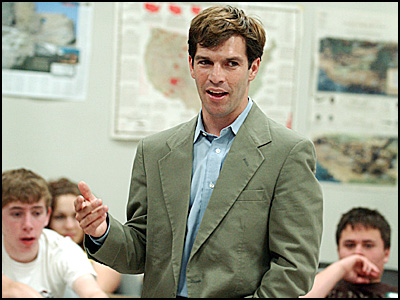Tomorrow, our very own contributing RP Jeff Smith will be appearing on MSNBC’s “The Cycle” to discuss the tragic situation in Ferguson, Missouri, from his unique perspective as a social scientist who represented the St. Louis region in the Missouri legislature.
Jeff has already emerged as the go-to guy for many national news sources on the continuing crisis.
This morning, the New York Times published his op-ed, “In Ferguson, Black Town, White Power” which answers the perplexing question as to why it appears that a majority African-American population is being governed by mostly white authorities. Here’s an excerpt:
POLITICS, wrote the political scientist Harold Lasswell in 1936, is about “who gets what, when, and how.” If you want to understand the racial power disparities we’ve seen in Ferguson, Mo., understand that it’s not only about black and white. It’s about green.
Back in 1876, the city of St. Louis made a fateful decision. Tired of providing services to the outlying areas, the city cordoned itself off, separating from St. Louis County. It’s a decision the city came to regret. Most Rust Belt cities have bled population since the 1960s, but few have been as badly damaged as St. Louis City, which since 1970 has lost almost as much of its population as Detroit.
This exodus has left a ring of mostly middle-class suburbs around an urban core plagued by entrenched poverty. White flight from the city mostly ended in the 1980s; since then, blacks have left the inner city for suburbs such as Ferguson in the area of St. Louis County known as North County.
Ferguson’s demographics have shifted rapidly: in 1990, it was 74 percent white and 25 percent black; in 2000, 52 percent black and 45 percent white; by 2010, 67 percent black and 29 percent white.
The region’s fragmentation isn’t limited to the odd case of a city shedding its county. St. Louis County contains 90 municipalities, most with their own city hall and police force. Many rely on revenue generated from traffic tickets and related fines. According to a study by the St. Louis nonprofit Better Together, Ferguson receives nearly one-quarter of its revenue from court fees; for some surrounding towns it approaches 50 percent.
Click here for the full piece.
Last week, Jeff wrote an influential piece for The New Republic, “You Can’t Understand Ferguson Without First Understanding These Three Things.” Here’s an excerpt:
You can’t really understand Ferguson—the now-famous St. Louis suburb with a long history of white people sometimes maliciously, sometimes not, imposing their will on black people’s lives—unless you understand Kinloch.
Kinloch, the oldest black town in Missouri, is now essentially a ghost town, but it wasn’t always that way. In fact, it thrived for nearly a century after its founding in the 1890s. Back then, restrictive housing covenants prohibited the direct sale of property to blacks, so a white real estate firm purchased parcels of land, marked them up over 100 percent, and resold them to blacks.” One advertisement noted, “The good colored people of South Kinloch Park have built themselves a little city of which they have a right to be proud. More than a hundred homes, three churches and a splendid public school have been built in a few years.”
The turn of the century was a heady time for the bustling little town. The Wright Brothers visited Kinloch Airfield in one of their earliest tours, and the airfield hosted an event at which Theodore Roosevelt took the maiden presidential airplane flight, which lasted approximately three minutes. Kinloch Airfield was home to the first control tower, the first aerial photo, and the first airmail shipped by a young pilot named Charles Lindbergh. A streetcar line ran through Ferguson, helping Kinloch residents travel to jobs throughout the region, and perhaps more importantly, exposing many whites to Kinloch as they passed through. Despite the region’s decidedly Southern folkways and segregated housing arrangements, blacks and whites rode the streetcars as equals. Kinloch itself was also notable for its relative enlightenment; despite school segregation, it became the first Missouri community to elect a black man to its school board.
All that began to change in 1938. A second black man sought election to the school board in the district which had a narrow black majority—whites inhabited the north and blacks the south—and whites responded by attempting to split the school district. It failed: 415 blacks in the south voted unanimously against the effort, while 215 whites in the north all supported it. So to get around the small problem of losing democratically, whites in the northern half of Kinloch immediately formed a new municipality called Berkeley, and a rare Missouri effort at integrated governance ended. Kinloch continued to thrive for the next several decades as a small nearly all-black town of churches, shops, community centers, and tidy homes.
In the 1980s, the airport—long since been renamed Lambert International Airport—began snatching up property to build an additional runway. From 1990 to 2000, Kinloch shed over 80 percent of its population, and as the community fabric frayed, it was increasingly plagued by crime and disorder.
Construction on airport expansion, which cost well over a billion dollars and involved 550 companies, began in 2001. Unfortunately, two other things happened that year: American Airlines bought TWA, and 9/11. Which means that the airport is dramatically underutilized now; a senior airport official told me Lambert could easily handle twice the traffic it currently gets.
Meanwhile, many of the residents displaced by this wasteful construction project have ended up in Ferguson—specifically, in Canfield Green, the apartment complex on whose grounds Michael Brown tragically died.
Click here for the full piece.
Jeff has also been burning up the Twitter feed (@JeffSmithMO) with his brilliant perspective on each day’s events. Click here to read a “Storify” of his last few days of tweeting.










Leave a Reply